Commercial Law Assignment: Consumer Law and Negligence Analysis
VerifiedAdded on 2023/06/04
|12
|3042
|460
Report
AI Summary
This report analyzes a commercial law case involving consumer rights and negligence. Part 1 focuses on a scenario where a consumer, Ann, seeks recourse against a salami manufacturer (Smallgoods Pty Ltd) and examines claims under the Australian Consumer Law, specifically sections 54 and 138. The analysis considers the manufacturer's duty to provide goods of acceptable quality and the implications of product defects. Part 2 assesses Ann's rights against a supermarket (Supermarkets Pty Ltd), exploring the retailer's liability and the application of consumer law principles. The report further discusses negligence, duty of care, breach of duty, causation, and remoteness in the context of a factory incident involving Shanti, evaluating the employer's responsibilities and potential liabilities based on tort law. The assignment demonstrates an understanding of relevant legal principles and their application to the given scenarios.
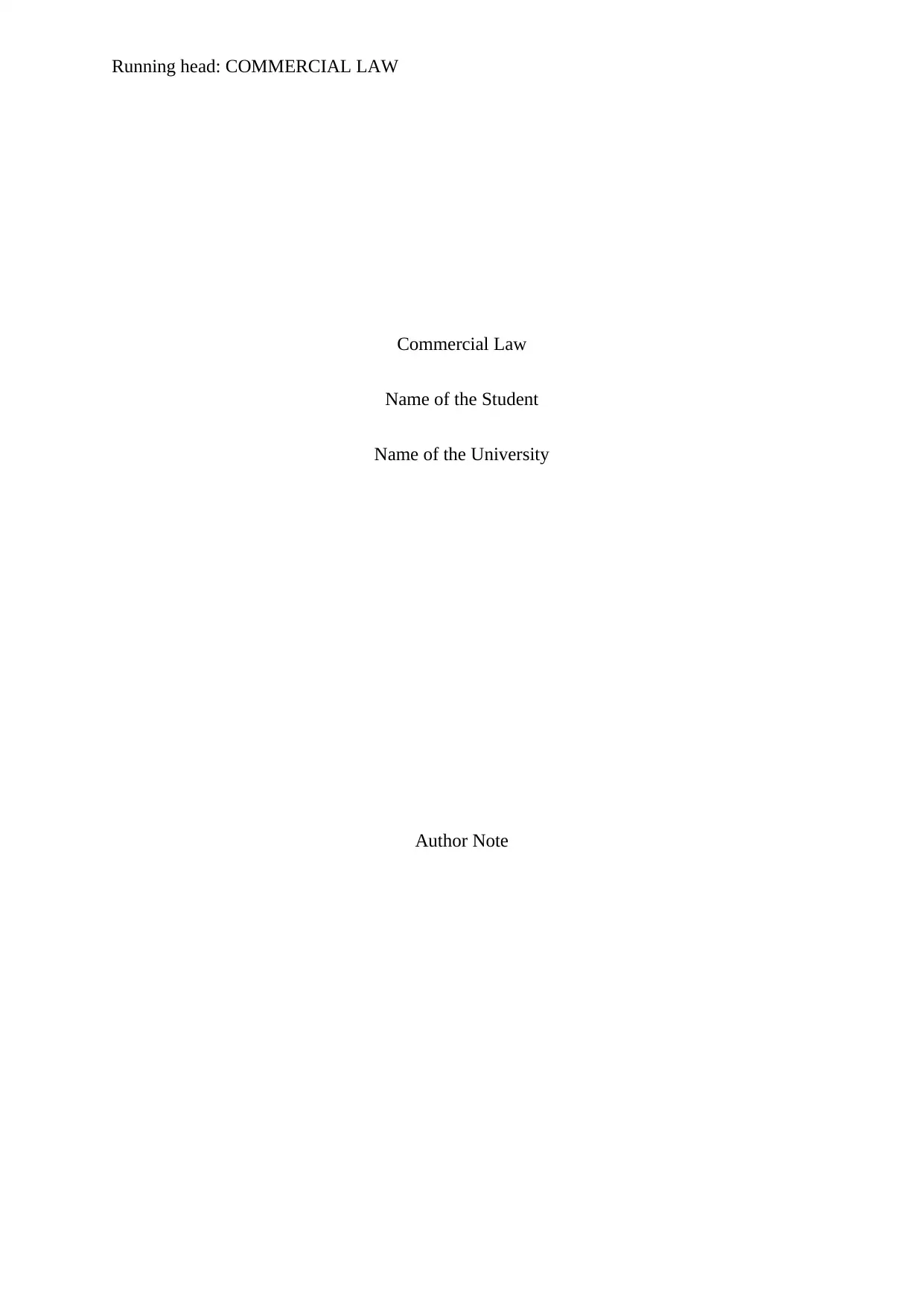
Running head: COMMERCIAL LAW
Commercial Law
Name of the Student
Name of the University
Author Note
Commercial Law
Name of the Student
Name of the University
Author Note
Paraphrase This Document
Need a fresh take? Get an instant paraphrase of this document with our AI Paraphraser
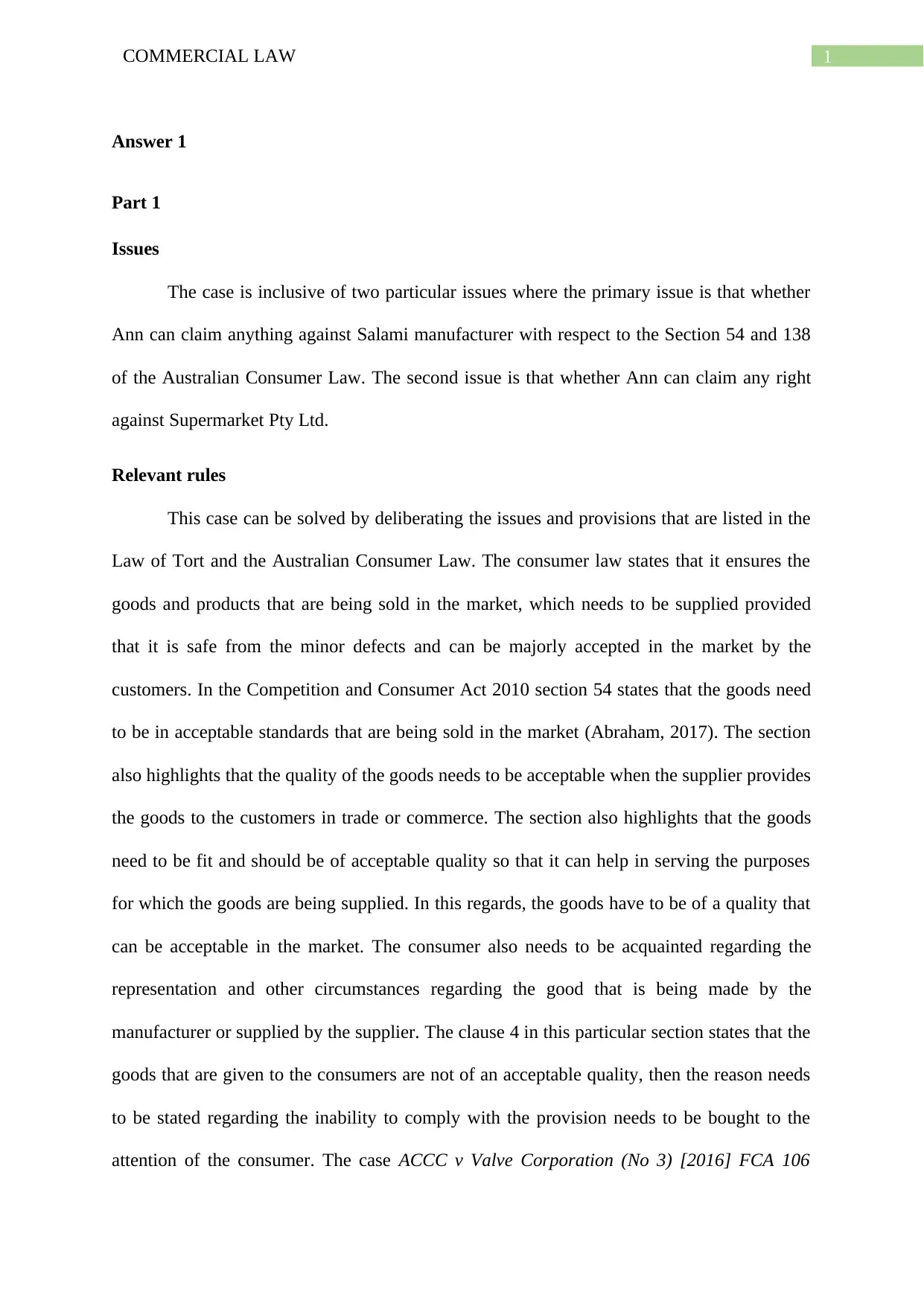
1COMMERCIAL LAW
Answer 1
Part 1
Issues
The case is inclusive of two particular issues where the primary issue is that whether
Ann can claim anything against Salami manufacturer with respect to the Section 54 and 138
of the Australian Consumer Law. The second issue is that whether Ann can claim any right
against Supermarket Pty Ltd.
Relevant rules
This case can be solved by deliberating the issues and provisions that are listed in the
Law of Tort and the Australian Consumer Law. The consumer law states that it ensures the
goods and products that are being sold in the market, which needs to be supplied provided
that it is safe from the minor defects and can be majorly accepted in the market by the
customers. In the Competition and Consumer Act 2010 section 54 states that the goods need
to be in acceptable standards that are being sold in the market (Abraham, 2017). The section
also highlights that the quality of the goods needs to be acceptable when the supplier provides
the goods to the customers in trade or commerce. The section also highlights that the goods
need to be fit and should be of acceptable quality so that it can help in serving the purposes
for which the goods are being supplied. In this regards, the goods have to be of a quality that
can be acceptable in the market. The consumer also needs to be acquainted regarding the
representation and other circumstances regarding the good that is being made by the
manufacturer or supplied by the supplier. The clause 4 in this particular section states that the
goods that are given to the consumers are not of an acceptable quality, then the reason needs
to be stated regarding the inability to comply with the provision needs to be bought to the
attention of the consumer. The case ACCC v Valve Corporation (No 3) [2016] FCA 106
Answer 1
Part 1
Issues
The case is inclusive of two particular issues where the primary issue is that whether
Ann can claim anything against Salami manufacturer with respect to the Section 54 and 138
of the Australian Consumer Law. The second issue is that whether Ann can claim any right
against Supermarket Pty Ltd.
Relevant rules
This case can be solved by deliberating the issues and provisions that are listed in the
Law of Tort and the Australian Consumer Law. The consumer law states that it ensures the
goods and products that are being sold in the market, which needs to be supplied provided
that it is safe from the minor defects and can be majorly accepted in the market by the
customers. In the Competition and Consumer Act 2010 section 54 states that the goods need
to be in acceptable standards that are being sold in the market (Abraham, 2017). The section
also highlights that the quality of the goods needs to be acceptable when the supplier provides
the goods to the customers in trade or commerce. The section also highlights that the goods
need to be fit and should be of acceptable quality so that it can help in serving the purposes
for which the goods are being supplied. In this regards, the goods have to be of a quality that
can be acceptable in the market. The consumer also needs to be acquainted regarding the
representation and other circumstances regarding the good that is being made by the
manufacturer or supplied by the supplier. The clause 4 in this particular section states that the
goods that are given to the consumers are not of an acceptable quality, then the reason needs
to be stated regarding the inability to comply with the provision needs to be bought to the
attention of the consumer. The case ACCC v Valve Corporation (No 3) [2016] FCA 106
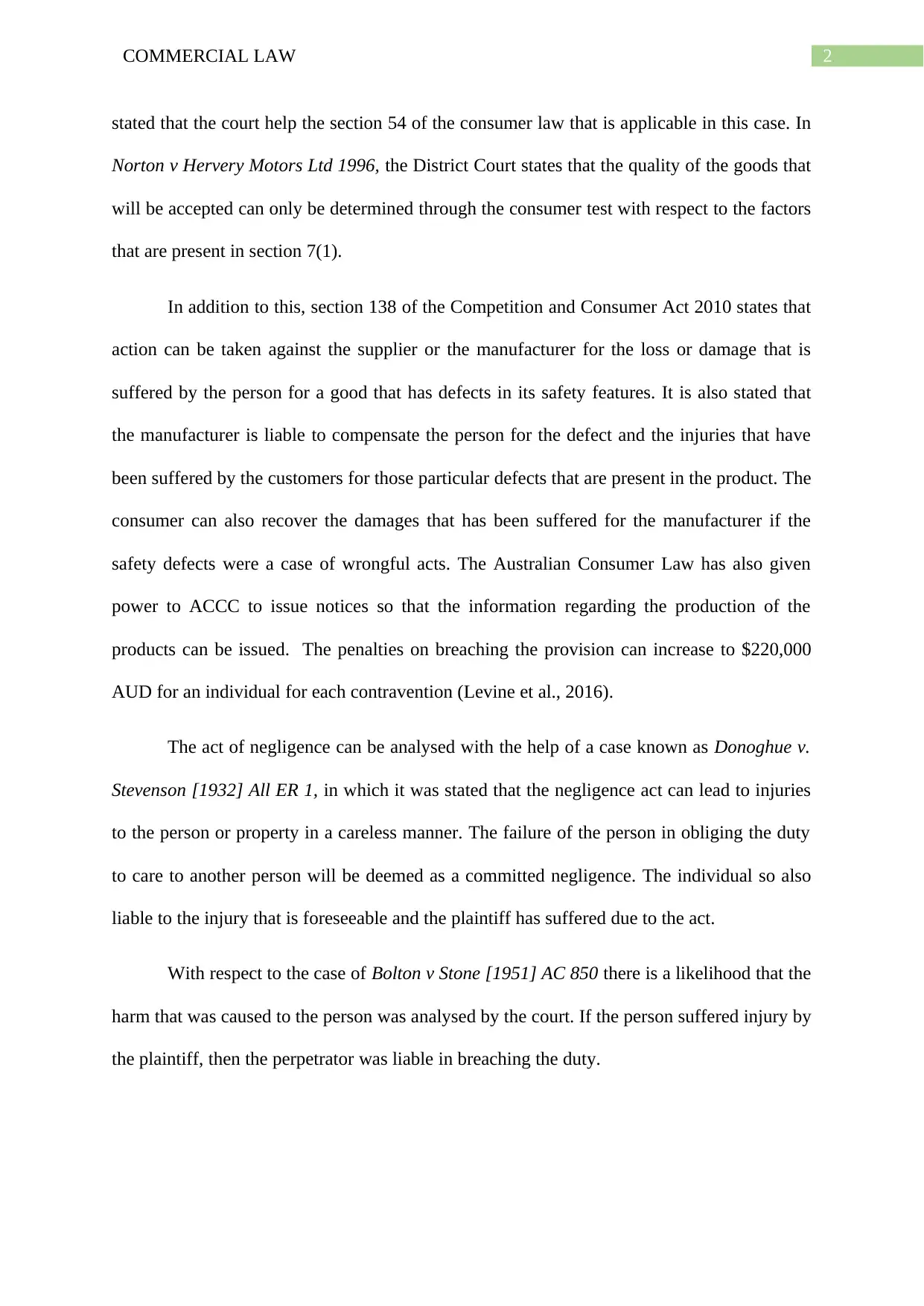
2COMMERCIAL LAW
stated that the court help the section 54 of the consumer law that is applicable in this case. In
Norton v Hervery Motors Ltd 1996, the District Court states that the quality of the goods that
will be accepted can only be determined through the consumer test with respect to the factors
that are present in section 7(1).
In addition to this, section 138 of the Competition and Consumer Act 2010 states that
action can be taken against the supplier or the manufacturer for the loss or damage that is
suffered by the person for a good that has defects in its safety features. It is also stated that
the manufacturer is liable to compensate the person for the defect and the injuries that have
been suffered by the customers for those particular defects that are present in the product. The
consumer can also recover the damages that has been suffered for the manufacturer if the
safety defects were a case of wrongful acts. The Australian Consumer Law has also given
power to ACCC to issue notices so that the information regarding the production of the
products can be issued. The penalties on breaching the provision can increase to $220,000
AUD for an individual for each contravention (Levine et al., 2016).
The act of negligence can be analysed with the help of a case known as Donoghue v.
Stevenson [1932] All ER 1, in which it was stated that the negligence act can lead to injuries
to the person or property in a careless manner. The failure of the person in obliging the duty
to care to another person will be deemed as a committed negligence. The individual so also
liable to the injury that is foreseeable and the plaintiff has suffered due to the act.
With respect to the case of Bolton v Stone [1951] AC 850 there is a likelihood that the
harm that was caused to the person was analysed by the court. If the person suffered injury by
the plaintiff, then the perpetrator was liable in breaching the duty.
stated that the court help the section 54 of the consumer law that is applicable in this case. In
Norton v Hervery Motors Ltd 1996, the District Court states that the quality of the goods that
will be accepted can only be determined through the consumer test with respect to the factors
that are present in section 7(1).
In addition to this, section 138 of the Competition and Consumer Act 2010 states that
action can be taken against the supplier or the manufacturer for the loss or damage that is
suffered by the person for a good that has defects in its safety features. It is also stated that
the manufacturer is liable to compensate the person for the defect and the injuries that have
been suffered by the customers for those particular defects that are present in the product. The
consumer can also recover the damages that has been suffered for the manufacturer if the
safety defects were a case of wrongful acts. The Australian Consumer Law has also given
power to ACCC to issue notices so that the information regarding the production of the
products can be issued. The penalties on breaching the provision can increase to $220,000
AUD for an individual for each contravention (Levine et al., 2016).
The act of negligence can be analysed with the help of a case known as Donoghue v.
Stevenson [1932] All ER 1, in which it was stated that the negligence act can lead to injuries
to the person or property in a careless manner. The failure of the person in obliging the duty
to care to another person will be deemed as a committed negligence. The individual so also
liable to the injury that is foreseeable and the plaintiff has suffered due to the act.
With respect to the case of Bolton v Stone [1951] AC 850 there is a likelihood that the
harm that was caused to the person was analysed by the court. If the person suffered injury by
the plaintiff, then the perpetrator was liable in breaching the duty.
⊘ This is a preview!⊘
Do you want full access?
Subscribe today to unlock all pages.

Trusted by 1+ million students worldwide

3COMMERCIAL LAW
Application
With respect to this case, it can be stated that there is a case of negligence on behalf of
Smallgoods Pty Ltd. The company produces meat products that are processed in nature and
they need to be careful regarding the particular batches that are being sold in the market. The
products need to undergo special treatment so that it can be free from bacteria. The product
that Ann purchased and later consumed it was not treated for bacteria process, which made
the product contaminated. This was a negligence that was caused on behalf of Smallgoods
Pty Ltd., as they did not perform the duty in a proper manner that resulted in poor health of
Ann. The duty to care was breached under section 54 of the Competition and Consumer Act
2010. The product had failed to meet the guarantee towards the customer with respect to the
safety of the product.
Therefore it has been identified that there was a breach of duty to care and the goods
of acceptable quality by the manufacturer Smallgoods Pty Ltd. who can be held liable under
section 138 of the Competition and Consumer Act 2010. The company sold goods that were
of unacceptable quality, which resulted in ill health of Ann. Thus, the duty of the company is
that if the product cannot meet the standard of acceptable quality, they need to provide reason
for that to the consumer. The company had failed in doing that and the damages are to be
provided by Smallgoods Pty Ltd to Ann.
Conclusion
Therefore it can be concluded that the company has been negligent in supplying the
goods that can meet the acceptable quality.
Application
With respect to this case, it can be stated that there is a case of negligence on behalf of
Smallgoods Pty Ltd. The company produces meat products that are processed in nature and
they need to be careful regarding the particular batches that are being sold in the market. The
products need to undergo special treatment so that it can be free from bacteria. The product
that Ann purchased and later consumed it was not treated for bacteria process, which made
the product contaminated. This was a negligence that was caused on behalf of Smallgoods
Pty Ltd., as they did not perform the duty in a proper manner that resulted in poor health of
Ann. The duty to care was breached under section 54 of the Competition and Consumer Act
2010. The product had failed to meet the guarantee towards the customer with respect to the
safety of the product.
Therefore it has been identified that there was a breach of duty to care and the goods
of acceptable quality by the manufacturer Smallgoods Pty Ltd. who can be held liable under
section 138 of the Competition and Consumer Act 2010. The company sold goods that were
of unacceptable quality, which resulted in ill health of Ann. Thus, the duty of the company is
that if the product cannot meet the standard of acceptable quality, they need to provide reason
for that to the consumer. The company had failed in doing that and the damages are to be
provided by Smallgoods Pty Ltd to Ann.
Conclusion
Therefore it can be concluded that the company has been negligent in supplying the
goods that can meet the acceptable quality.
Paraphrase This Document
Need a fresh take? Get an instant paraphrase of this document with our AI Paraphraser
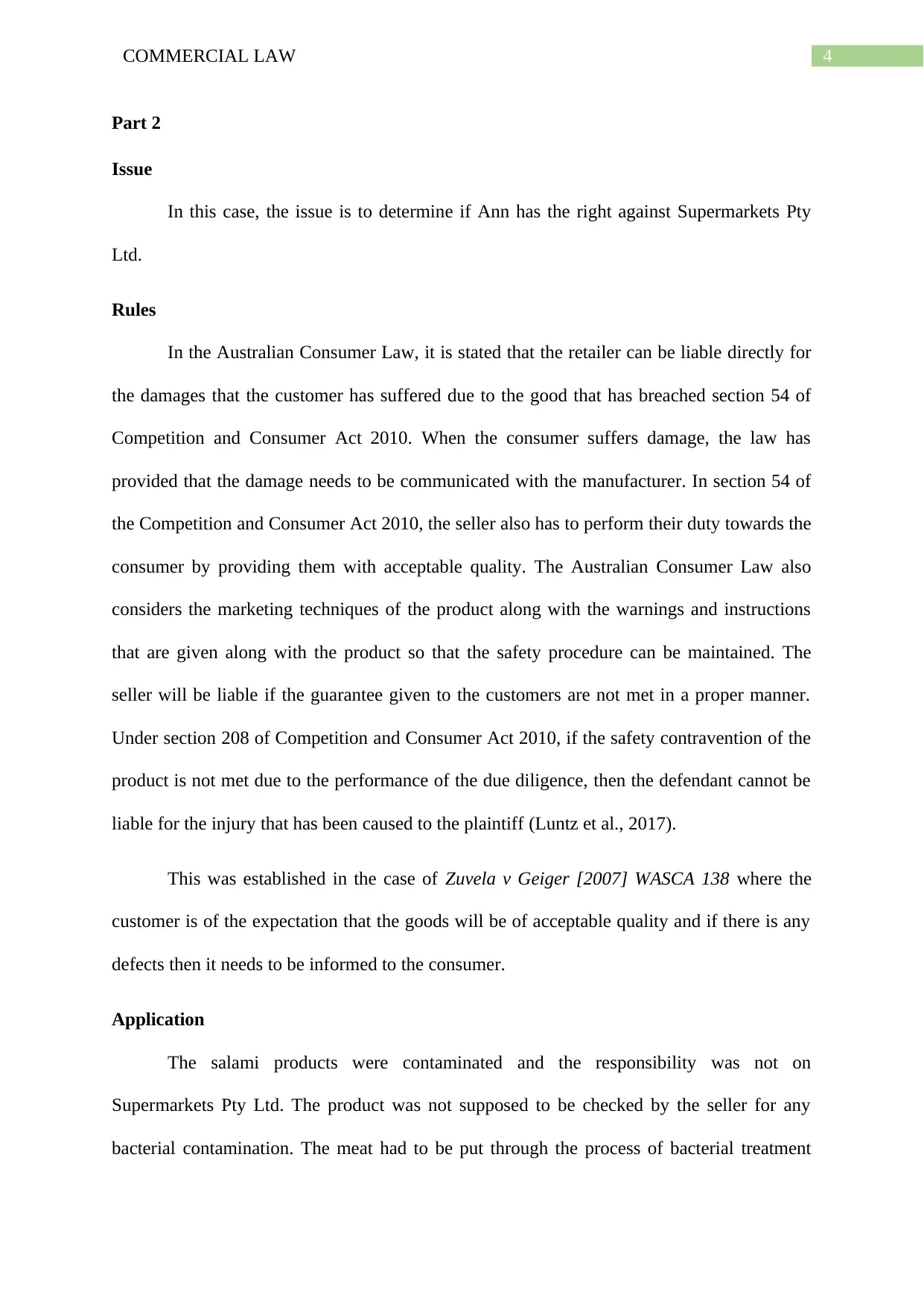
4COMMERCIAL LAW
Part 2
Issue
In this case, the issue is to determine if Ann has the right against Supermarkets Pty
Ltd.
Rules
In the Australian Consumer Law, it is stated that the retailer can be liable directly for
the damages that the customer has suffered due to the good that has breached section 54 of
Competition and Consumer Act 2010. When the consumer suffers damage, the law has
provided that the damage needs to be communicated with the manufacturer. In section 54 of
the Competition and Consumer Act 2010, the seller also has to perform their duty towards the
consumer by providing them with acceptable quality. The Australian Consumer Law also
considers the marketing techniques of the product along with the warnings and instructions
that are given along with the product so that the safety procedure can be maintained. The
seller will be liable if the guarantee given to the customers are not met in a proper manner.
Under section 208 of Competition and Consumer Act 2010, if the safety contravention of the
product is not met due to the performance of the due diligence, then the defendant cannot be
liable for the injury that has been caused to the plaintiff (Luntz et al., 2017).
This was established in the case of Zuvela v Geiger [2007] WASCA 138 where the
customer is of the expectation that the goods will be of acceptable quality and if there is any
defects then it needs to be informed to the consumer.
Application
The salami products were contaminated and the responsibility was not on
Supermarkets Pty Ltd. The product was not supposed to be checked by the seller for any
bacterial contamination. The meat had to be put through the process of bacterial treatment
Part 2
Issue
In this case, the issue is to determine if Ann has the right against Supermarkets Pty
Ltd.
Rules
In the Australian Consumer Law, it is stated that the retailer can be liable directly for
the damages that the customer has suffered due to the good that has breached section 54 of
Competition and Consumer Act 2010. When the consumer suffers damage, the law has
provided that the damage needs to be communicated with the manufacturer. In section 54 of
the Competition and Consumer Act 2010, the seller also has to perform their duty towards the
consumer by providing them with acceptable quality. The Australian Consumer Law also
considers the marketing techniques of the product along with the warnings and instructions
that are given along with the product so that the safety procedure can be maintained. The
seller will be liable if the guarantee given to the customers are not met in a proper manner.
Under section 208 of Competition and Consumer Act 2010, if the safety contravention of the
product is not met due to the performance of the due diligence, then the defendant cannot be
liable for the injury that has been caused to the plaintiff (Luntz et al., 2017).
This was established in the case of Zuvela v Geiger [2007] WASCA 138 where the
customer is of the expectation that the goods will be of acceptable quality and if there is any
defects then it needs to be informed to the consumer.
Application
The salami products were contaminated and the responsibility was not on
Supermarkets Pty Ltd. The product was not supposed to be checked by the seller for any
bacterial contamination. The meat had to be put through the process of bacterial treatment
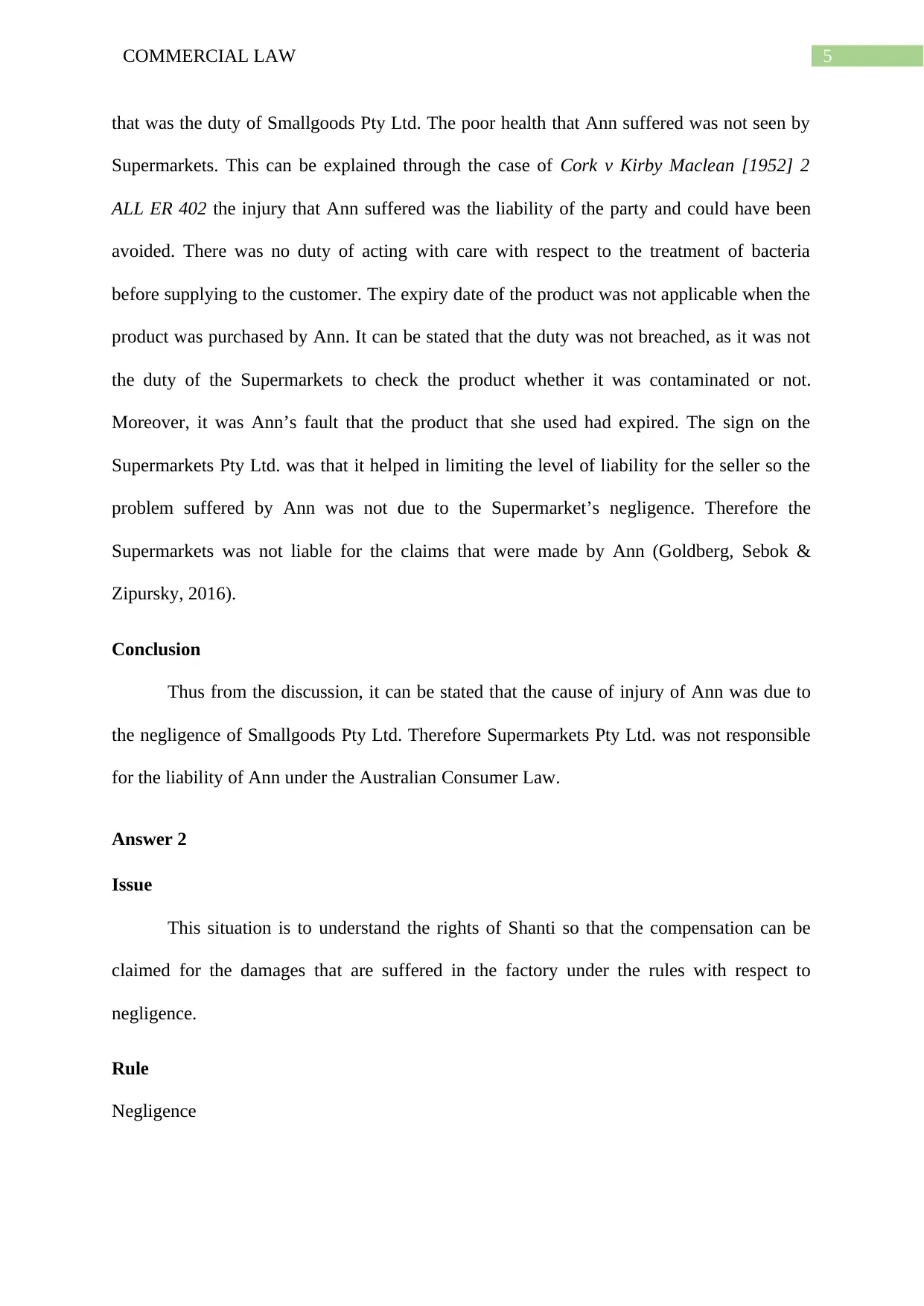
5COMMERCIAL LAW
that was the duty of Smallgoods Pty Ltd. The poor health that Ann suffered was not seen by
Supermarkets. This can be explained through the case of Cork v Kirby Maclean [1952] 2
ALL ER 402 the injury that Ann suffered was the liability of the party and could have been
avoided. There was no duty of acting with care with respect to the treatment of bacteria
before supplying to the customer. The expiry date of the product was not applicable when the
product was purchased by Ann. It can be stated that the duty was not breached, as it was not
the duty of the Supermarkets to check the product whether it was contaminated or not.
Moreover, it was Ann’s fault that the product that she used had expired. The sign on the
Supermarkets Pty Ltd. was that it helped in limiting the level of liability for the seller so the
problem suffered by Ann was not due to the Supermarket’s negligence. Therefore the
Supermarkets was not liable for the claims that were made by Ann (Goldberg, Sebok &
Zipursky, 2016).
Conclusion
Thus from the discussion, it can be stated that the cause of injury of Ann was due to
the negligence of Smallgoods Pty Ltd. Therefore Supermarkets Pty Ltd. was not responsible
for the liability of Ann under the Australian Consumer Law.
Answer 2
Issue
This situation is to understand the rights of Shanti so that the compensation can be
claimed for the damages that are suffered in the factory under the rules with respect to
negligence.
Rule
Negligence
that was the duty of Smallgoods Pty Ltd. The poor health that Ann suffered was not seen by
Supermarkets. This can be explained through the case of Cork v Kirby Maclean [1952] 2
ALL ER 402 the injury that Ann suffered was the liability of the party and could have been
avoided. There was no duty of acting with care with respect to the treatment of bacteria
before supplying to the customer. The expiry date of the product was not applicable when the
product was purchased by Ann. It can be stated that the duty was not breached, as it was not
the duty of the Supermarkets to check the product whether it was contaminated or not.
Moreover, it was Ann’s fault that the product that she used had expired. The sign on the
Supermarkets Pty Ltd. was that it helped in limiting the level of liability for the seller so the
problem suffered by Ann was not due to the Supermarket’s negligence. Therefore the
Supermarkets was not liable for the claims that were made by Ann (Goldberg, Sebok &
Zipursky, 2016).
Conclusion
Thus from the discussion, it can be stated that the cause of injury of Ann was due to
the negligence of Smallgoods Pty Ltd. Therefore Supermarkets Pty Ltd. was not responsible
for the liability of Ann under the Australian Consumer Law.
Answer 2
Issue
This situation is to understand the rights of Shanti so that the compensation can be
claimed for the damages that are suffered in the factory under the rules with respect to
negligence.
Rule
Negligence
⊘ This is a preview!⊘
Do you want full access?
Subscribe today to unlock all pages.

Trusted by 1+ million students worldwide
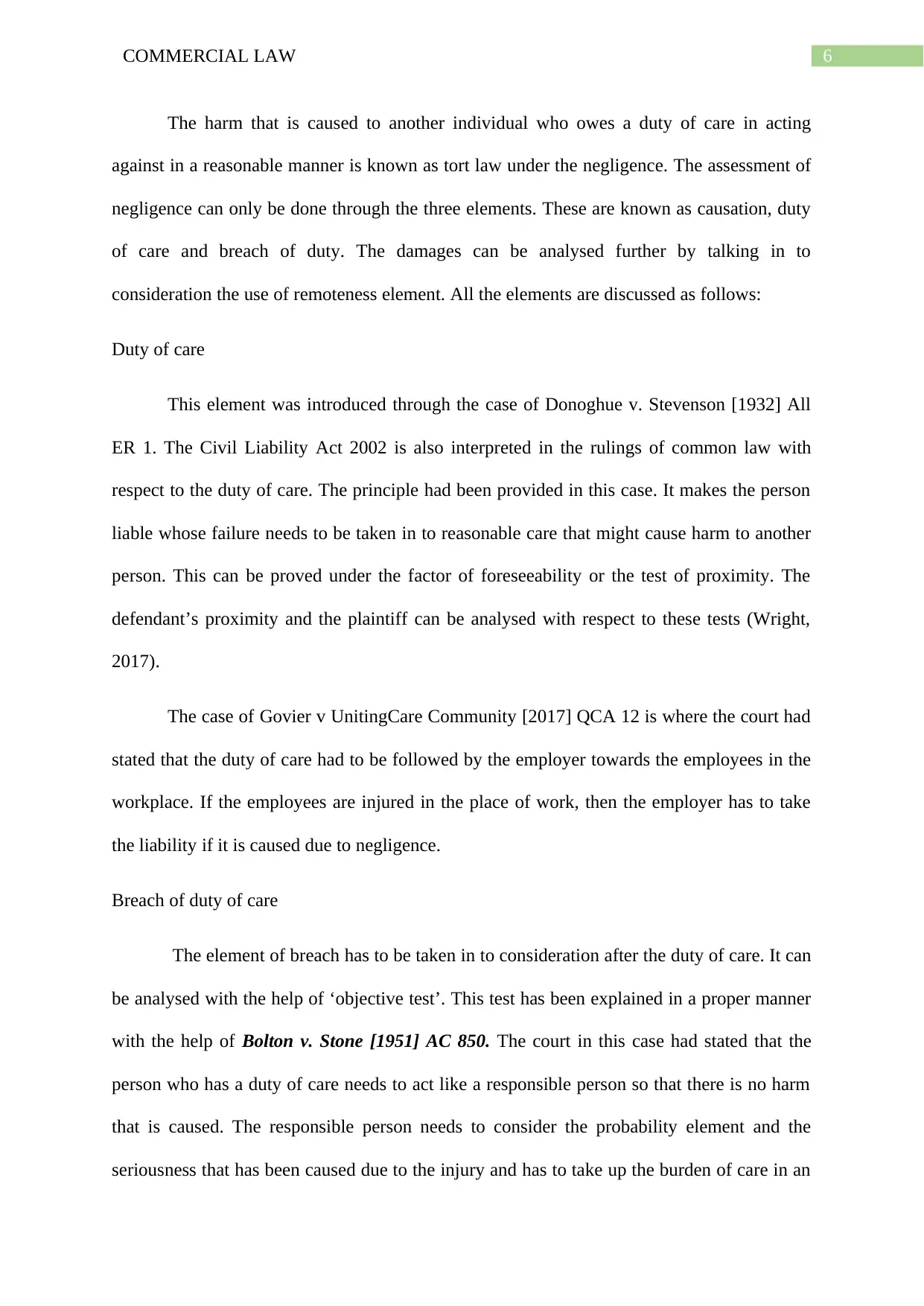
6COMMERCIAL LAW
The harm that is caused to another individual who owes a duty of care in acting
against in a reasonable manner is known as tort law under the negligence. The assessment of
negligence can only be done through the three elements. These are known as causation, duty
of care and breach of duty. The damages can be analysed further by talking in to
consideration the use of remoteness element. All the elements are discussed as follows:
Duty of care
This element was introduced through the case of Donoghue v. Stevenson [1932] All
ER 1. The Civil Liability Act 2002 is also interpreted in the rulings of common law with
respect to the duty of care. The principle had been provided in this case. It makes the person
liable whose failure needs to be taken in to reasonable care that might cause harm to another
person. This can be proved under the factor of foreseeability or the test of proximity. The
defendant’s proximity and the plaintiff can be analysed with respect to these tests (Wright,
2017).
The case of Govier v UnitingCare Community [2017] QCA 12 is where the court had
stated that the duty of care had to be followed by the employer towards the employees in the
workplace. If the employees are injured in the place of work, then the employer has to take
the liability if it is caused due to negligence.
Breach of duty of care
The element of breach has to be taken in to consideration after the duty of care. It can
be analysed with the help of ‘objective test’. This test has been explained in a proper manner
with the help of Bolton v. Stone [1951] AC 850. The court in this case had stated that the
person who has a duty of care needs to act like a responsible person so that there is no harm
that is caused. The responsible person needs to consider the probability element and the
seriousness that has been caused due to the injury and has to take up the burden of care in an
The harm that is caused to another individual who owes a duty of care in acting
against in a reasonable manner is known as tort law under the negligence. The assessment of
negligence can only be done through the three elements. These are known as causation, duty
of care and breach of duty. The damages can be analysed further by talking in to
consideration the use of remoteness element. All the elements are discussed as follows:
Duty of care
This element was introduced through the case of Donoghue v. Stevenson [1932] All
ER 1. The Civil Liability Act 2002 is also interpreted in the rulings of common law with
respect to the duty of care. The principle had been provided in this case. It makes the person
liable whose failure needs to be taken in to reasonable care that might cause harm to another
person. This can be proved under the factor of foreseeability or the test of proximity. The
defendant’s proximity and the plaintiff can be analysed with respect to these tests (Wright,
2017).
The case of Govier v UnitingCare Community [2017] QCA 12 is where the court had
stated that the duty of care had to be followed by the employer towards the employees in the
workplace. If the employees are injured in the place of work, then the employer has to take
the liability if it is caused due to negligence.
Breach of duty of care
The element of breach has to be taken in to consideration after the duty of care. It can
be analysed with the help of ‘objective test’. This test has been explained in a proper manner
with the help of Bolton v. Stone [1951] AC 850. The court in this case had stated that the
person who has a duty of care needs to act like a responsible person so that there is no harm
that is caused. The responsible person needs to consider the probability element and the
seriousness that has been caused due to the injury and has to take up the burden of care in an
Paraphrase This Document
Need a fresh take? Get an instant paraphrase of this document with our AI Paraphraser
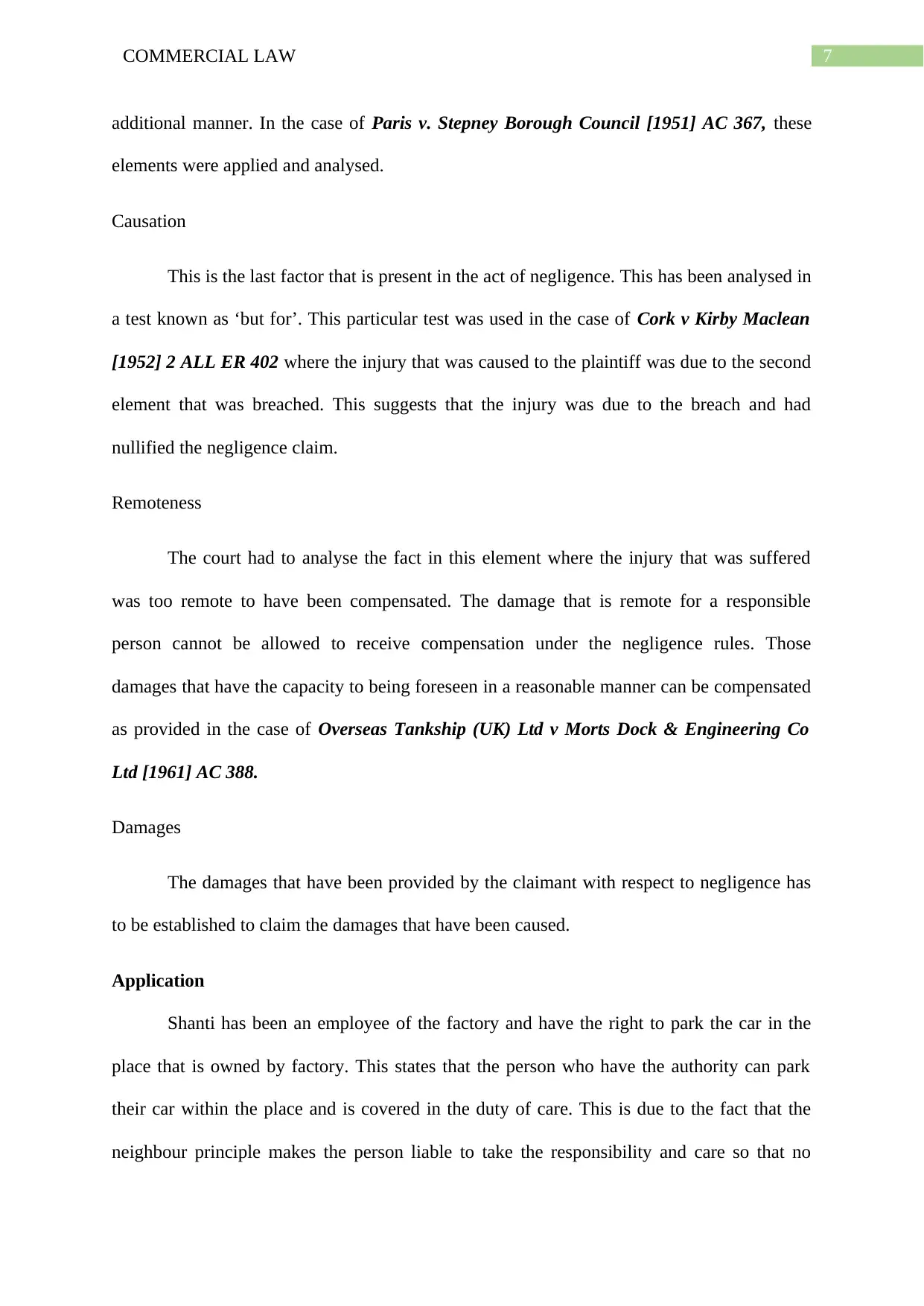
7COMMERCIAL LAW
additional manner. In the case of Paris v. Stepney Borough Council [1951] AC 367, these
elements were applied and analysed.
Causation
This is the last factor that is present in the act of negligence. This has been analysed in
a test known as ‘but for’. This particular test was used in the case of Cork v Kirby Maclean
[1952] 2 ALL ER 402 where the injury that was caused to the plaintiff was due to the second
element that was breached. This suggests that the injury was due to the breach and had
nullified the negligence claim.
Remoteness
The court had to analyse the fact in this element where the injury that was suffered
was too remote to have been compensated. The damage that is remote for a responsible
person cannot be allowed to receive compensation under the negligence rules. Those
damages that have the capacity to being foreseen in a reasonable manner can be compensated
as provided in the case of Overseas Tankship (UK) Ltd v Morts Dock & Engineering Co
Ltd [1961] AC 388.
Damages
The damages that have been provided by the claimant with respect to negligence has
to be established to claim the damages that have been caused.
Application
Shanti has been an employee of the factory and have the right to park the car in the
place that is owned by factory. This states that the person who have the authority can park
their car within the place and is covered in the duty of care. This is due to the fact that the
neighbour principle makes the person liable to take the responsibility and care so that no
additional manner. In the case of Paris v. Stepney Borough Council [1951] AC 367, these
elements were applied and analysed.
Causation
This is the last factor that is present in the act of negligence. This has been analysed in
a test known as ‘but for’. This particular test was used in the case of Cork v Kirby Maclean
[1952] 2 ALL ER 402 where the injury that was caused to the plaintiff was due to the second
element that was breached. This suggests that the injury was due to the breach and had
nullified the negligence claim.
Remoteness
The court had to analyse the fact in this element where the injury that was suffered
was too remote to have been compensated. The damage that is remote for a responsible
person cannot be allowed to receive compensation under the negligence rules. Those
damages that have the capacity to being foreseen in a reasonable manner can be compensated
as provided in the case of Overseas Tankship (UK) Ltd v Morts Dock & Engineering Co
Ltd [1961] AC 388.
Damages
The damages that have been provided by the claimant with respect to negligence has
to be established to claim the damages that have been caused.
Application
Shanti has been an employee of the factory and have the right to park the car in the
place that is owned by factory. This states that the person who have the authority can park
their car within the place and is covered in the duty of care. This is due to the fact that the
neighbour principle makes the person liable to take the responsibility and care so that no

8COMMERCIAL LAW
harm can be caused to another person. In the case of Govier vs UnitingCare Community, it
has been stated that the employees who are injured within the work place has to be taken care
by the employer, as it falls under their liability. Thus the factory owes a duty to take care of
Shanti.
The factor has a duty of car towards Shanti and it can be seen that the breach of duty
for the second element. The test of objective claims that the person who has a duty of care
needs to act as a responsible person so that the harm can be prevented. The responsible
person needs to take in to consideration the elements of seriousness and probability of the
level of injury along with the burden of additional care. Thus in this case, the manager in the
factory acted as a responsible person towards the injury that happened to Shanti (Epstein &
Sharkey, 2016).
Probability- It is evident from the fact that the failure in taking up the responsibility of care
with respect to the parking may result in causing injuries to the car owners or the other
properties. This is due to the fact that there are instances of car theft from the parking lot.
Seriousness- The injury to the car owners are serious to the car owners along with the other
properties. This is due to the fact that the people may get injured in a serious manner due to
car theft or other physical injuries (Stickley, 2016).
Precautionary burden- The case of Shanti has shown that the security measures need to be
enhanced such as lights need to be placed, as it is dark, which may cause serious injuries.
Thus there has been a breach in the duty of care.
The factor of causation is also present and the ‘but for’ test needs to be applied, as the
thief would then not have come and injured the claimant if the security measures would have
been increased.
harm can be caused to another person. In the case of Govier vs UnitingCare Community, it
has been stated that the employees who are injured within the work place has to be taken care
by the employer, as it falls under their liability. Thus the factory owes a duty to take care of
Shanti.
The factor has a duty of car towards Shanti and it can be seen that the breach of duty
for the second element. The test of objective claims that the person who has a duty of care
needs to act as a responsible person so that the harm can be prevented. The responsible
person needs to take in to consideration the elements of seriousness and probability of the
level of injury along with the burden of additional care. Thus in this case, the manager in the
factory acted as a responsible person towards the injury that happened to Shanti (Epstein &
Sharkey, 2016).
Probability- It is evident from the fact that the failure in taking up the responsibility of care
with respect to the parking may result in causing injuries to the car owners or the other
properties. This is due to the fact that there are instances of car theft from the parking lot.
Seriousness- The injury to the car owners are serious to the car owners along with the other
properties. This is due to the fact that the people may get injured in a serious manner due to
car theft or other physical injuries (Stickley, 2016).
Precautionary burden- The case of Shanti has shown that the security measures need to be
enhanced such as lights need to be placed, as it is dark, which may cause serious injuries.
Thus there has been a breach in the duty of care.
The factor of causation is also present and the ‘but for’ test needs to be applied, as the
thief would then not have come and injured the claimant if the security measures would have
been increased.
⊘ This is a preview!⊘
Do you want full access?
Subscribe today to unlock all pages.

Trusted by 1+ million students worldwide
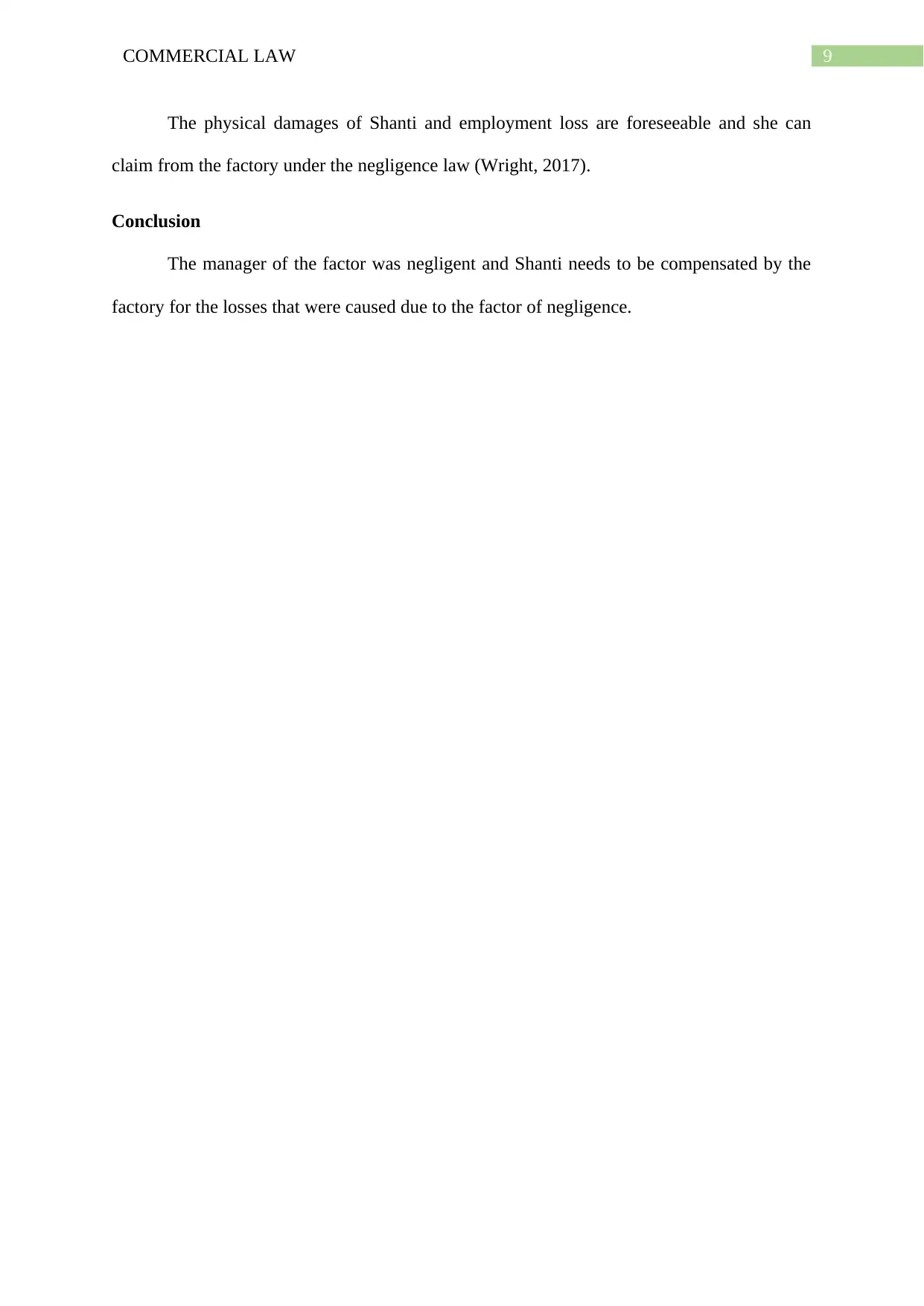
9COMMERCIAL LAW
The physical damages of Shanti and employment loss are foreseeable and she can
claim from the factory under the negligence law (Wright, 2017).
Conclusion
The manager of the factor was negligent and Shanti needs to be compensated by the
factory for the losses that were caused due to the factor of negligence.
The physical damages of Shanti and employment loss are foreseeable and she can
claim from the factory under the negligence law (Wright, 2017).
Conclusion
The manager of the factor was negligent and Shanti needs to be compensated by the
factory for the losses that were caused due to the factor of negligence.
Paraphrase This Document
Need a fresh take? Get an instant paraphrase of this document with our AI Paraphraser
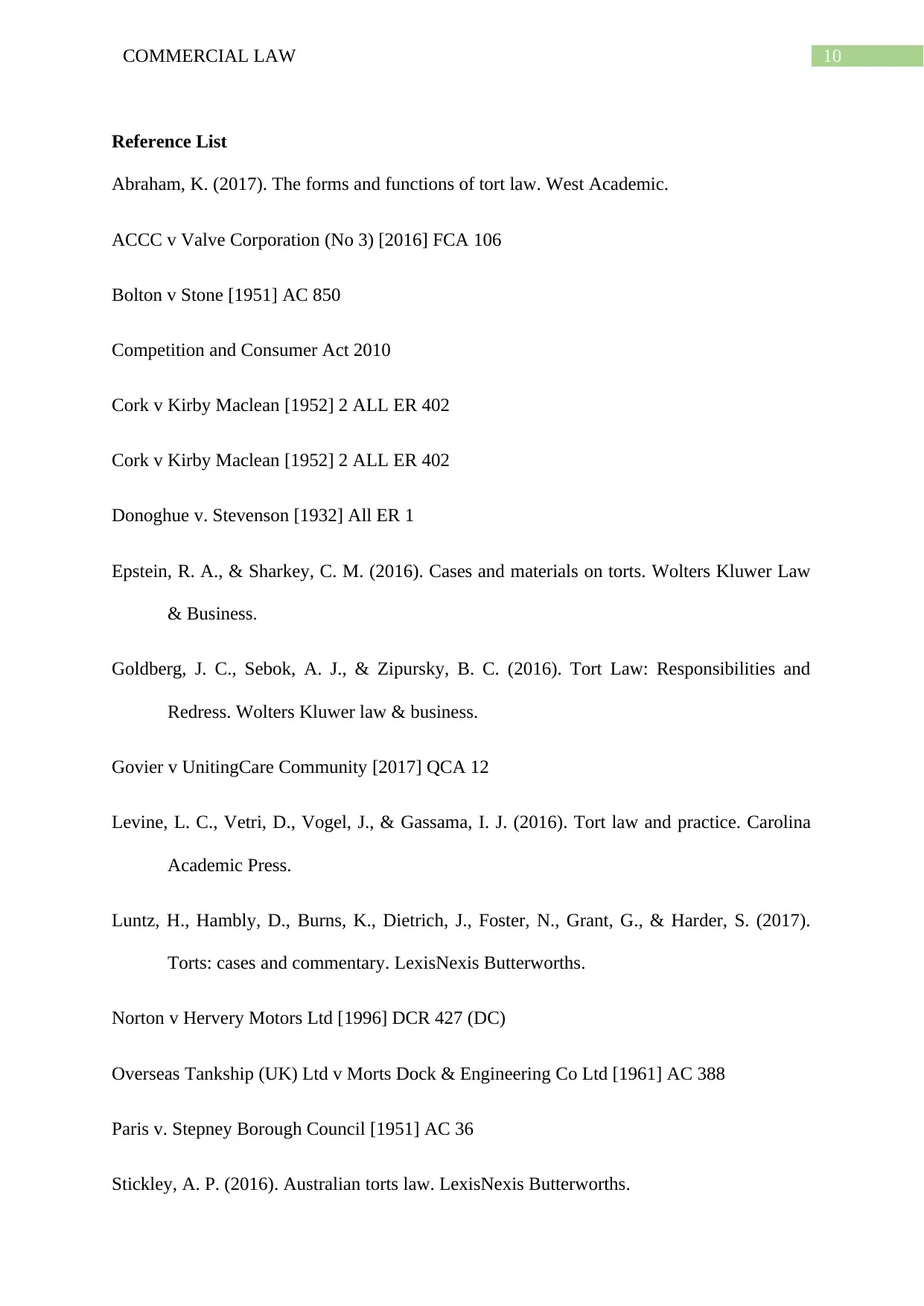
10COMMERCIAL LAW
Reference List
Abraham, K. (2017). The forms and functions of tort law. West Academic.
ACCC v Valve Corporation (No 3) [2016] FCA 106
Bolton v Stone [1951] AC 850
Competition and Consumer Act 2010
Cork v Kirby Maclean [1952] 2 ALL ER 402
Cork v Kirby Maclean [1952] 2 ALL ER 402
Donoghue v. Stevenson [1932] All ER 1
Epstein, R. A., & Sharkey, C. M. (2016). Cases and materials on torts. Wolters Kluwer Law
& Business.
Goldberg, J. C., Sebok, A. J., & Zipursky, B. C. (2016). Tort Law: Responsibilities and
Redress. Wolters Kluwer law & business.
Govier v UnitingCare Community [2017] QCA 12
Levine, L. C., Vetri, D., Vogel, J., & Gassama, I. J. (2016). Tort law and practice. Carolina
Academic Press.
Luntz, H., Hambly, D., Burns, K., Dietrich, J., Foster, N., Grant, G., & Harder, S. (2017).
Torts: cases and commentary. LexisNexis Butterworths.
Norton v Hervery Motors Ltd [1996] DCR 427 (DC)
Overseas Tankship (UK) Ltd v Morts Dock & Engineering Co Ltd [1961] AC 388
Paris v. Stepney Borough Council [1951] AC 36
Stickley, A. P. (2016). Australian torts law. LexisNexis Butterworths.
Reference List
Abraham, K. (2017). The forms and functions of tort law. West Academic.
ACCC v Valve Corporation (No 3) [2016] FCA 106
Bolton v Stone [1951] AC 850
Competition and Consumer Act 2010
Cork v Kirby Maclean [1952] 2 ALL ER 402
Cork v Kirby Maclean [1952] 2 ALL ER 402
Donoghue v. Stevenson [1932] All ER 1
Epstein, R. A., & Sharkey, C. M. (2016). Cases and materials on torts. Wolters Kluwer Law
& Business.
Goldberg, J. C., Sebok, A. J., & Zipursky, B. C. (2016). Tort Law: Responsibilities and
Redress. Wolters Kluwer law & business.
Govier v UnitingCare Community [2017] QCA 12
Levine, L. C., Vetri, D., Vogel, J., & Gassama, I. J. (2016). Tort law and practice. Carolina
Academic Press.
Luntz, H., Hambly, D., Burns, K., Dietrich, J., Foster, N., Grant, G., & Harder, S. (2017).
Torts: cases and commentary. LexisNexis Butterworths.
Norton v Hervery Motors Ltd [1996] DCR 427 (DC)
Overseas Tankship (UK) Ltd v Morts Dock & Engineering Co Ltd [1961] AC 388
Paris v. Stepney Borough Council [1951] AC 36
Stickley, A. P. (2016). Australian torts law. LexisNexis Butterworths.
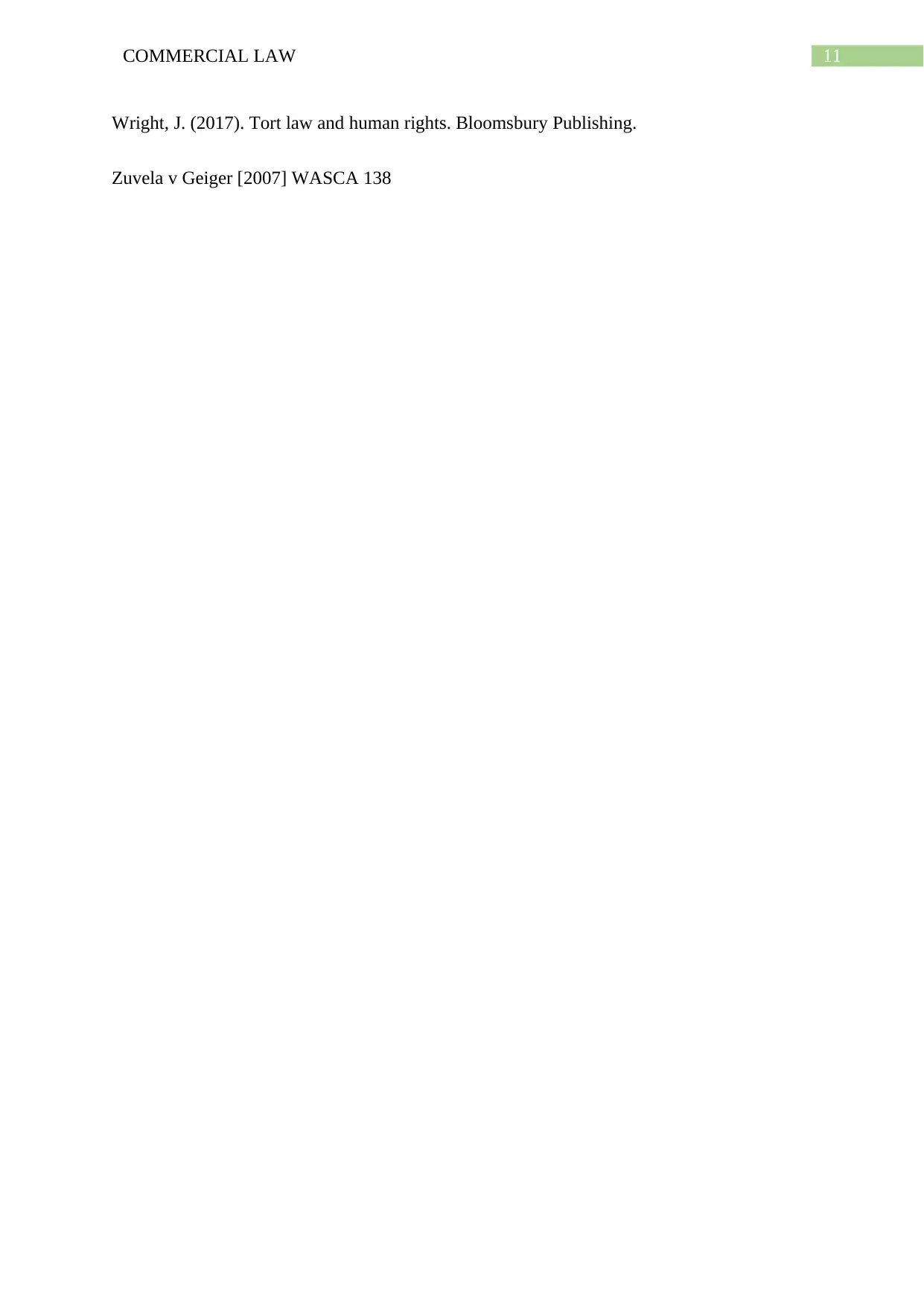
11COMMERCIAL LAW
Wright, J. (2017). Tort law and human rights. Bloomsbury Publishing.
Zuvela v Geiger [2007] WASCA 138
Wright, J. (2017). Tort law and human rights. Bloomsbury Publishing.
Zuvela v Geiger [2007] WASCA 138
⊘ This is a preview!⊘
Do you want full access?
Subscribe today to unlock all pages.

Trusted by 1+ million students worldwide
1 out of 12